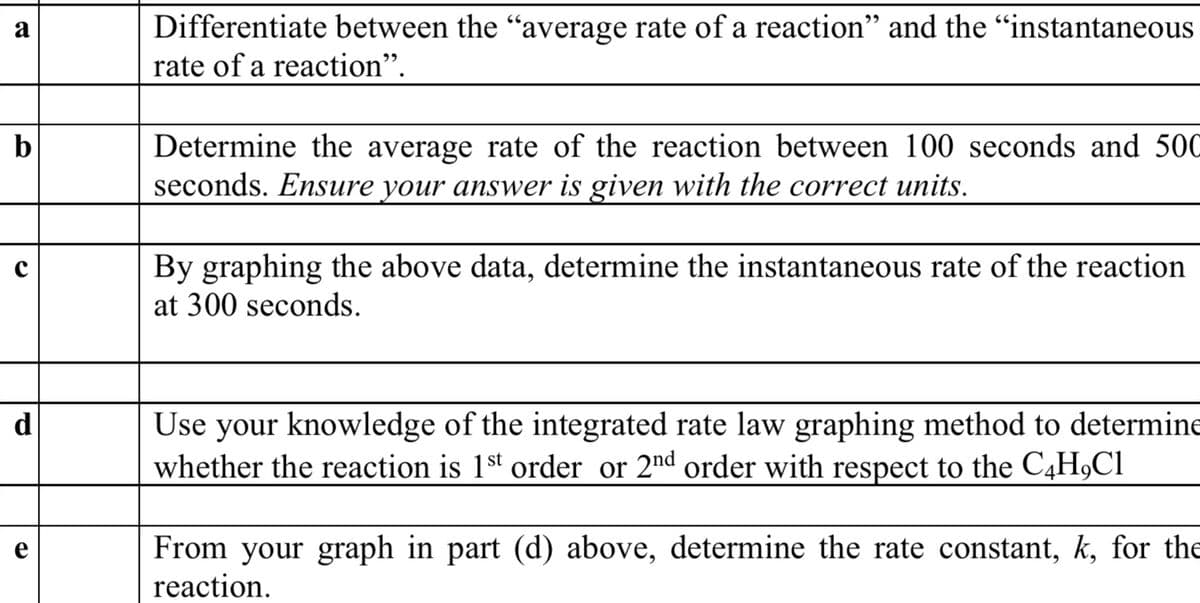C4H9CI(ag) + H2O(1) → C4H9OH(ag) + HCl(ag) Time/sec [C4H9C] 0.1000 50 0.0905 100 0.0820 150 0.0741 200 0.0671 300 0.0549 400 0.0448 500 0.0368 800 0.0200 Differentiate between the "average rate of a reaction" and the "instantaneous rate of a reaction". a Determine the average rate of the reaction between 100 seconds and 500 seconds. Ensure your answer is given with the correct units. b By graphing the above data, determine the instantaneous rate of the reaction at 300 seconds. с
C4H9CI(ag) + H2O(1) → C4H9OH(ag) + HCl(ag) Time/sec [C4H9C] 0.1000 50 0.0905 100 0.0820 150 0.0741 200 0.0671 300 0.0549 400 0.0448 500 0.0368 800 0.0200 Differentiate between the "average rate of a reaction" and the "instantaneous rate of a reaction". a Determine the average rate of the reaction between 100 seconds and 500 seconds. Ensure your answer is given with the correct units. b By graphing the above data, determine the instantaneous rate of the reaction at 300 seconds. с
Chemistry: The Molecular Science
5th Edition
ISBN:9781285199047
Author:John W. Moore, Conrad L. Stanitski
Publisher:John W. Moore, Conrad L. Stanitski
Chapter11: Chemical Kinetics: Rates Of Reactions
Section: Chapter Questions
Problem 115QRT
Related questions
Question

Transcribed Image Text:Differentiate between the "average rate of a reaction" and the "instantaneous
rate of a reaction".
а
Determine the average rate of the reaction between 100 seconds and 500
seconds. Ensure your answer is given with the correct units.
By graphing the above data, determine the instantaneous rate of the reaction
at 300 seconds.
d
Use your knowledge of the integrated rate law graphing method to determine
whether the reaction is 1st order or 2nd order with respect to the C4H,Cl
From your graph in part (d) above, determine the rate constant, k, for the
reaction.
![1
Consider the reaction and the following experimental data:
C4H9CI(aq) + H2O1)→ C4H9OH(aqg) + HCl(aq).
Time/sec
[C4H9CI]
0.1000
50
0.0905
100
0.0820
150
0.0741
200
0.0671
300
0.0549
400
0.0448
500
0.0368
800
0.0200
Differentiate between the "average rate of a reaction" and the "instantaneous
rate of a reaction".
a
Determine the average rate of the reaction between 100 seconds and 500
seconds. Ensure your answer is given with the correct units.
b
By graphing the above data, determine the instantaneous rate of the reaction
at 300 seconds.](/v2/_next/image?url=https%3A%2F%2Fcontent.bartleby.com%2Fqna-images%2Fquestion%2F69e4bd65-d657-4494-99ca-24ee82035403%2Fc4b20ba7-7b9d-4c15-9882-6c098dee1944%2Fq4fys6e_processed.jpeg&w=3840&q=75)
Transcribed Image Text:1
Consider the reaction and the following experimental data:
C4H9CI(aq) + H2O1)→ C4H9OH(aqg) + HCl(aq).
Time/sec
[C4H9CI]
0.1000
50
0.0905
100
0.0820
150
0.0741
200
0.0671
300
0.0549
400
0.0448
500
0.0368
800
0.0200
Differentiate between the "average rate of a reaction" and the "instantaneous
rate of a reaction".
a
Determine the average rate of the reaction between 100 seconds and 500
seconds. Ensure your answer is given with the correct units.
b
By graphing the above data, determine the instantaneous rate of the reaction
at 300 seconds.
Expert Solution
This question has been solved!
Explore an expertly crafted, step-by-step solution for a thorough understanding of key concepts.
Step by step
Solved in 4 steps

Knowledge Booster
Learn more about
Need a deep-dive on the concept behind this application? Look no further. Learn more about this topic, chemistry and related others by exploring similar questions and additional content below.Recommended textbooks for you

Chemistry: The Molecular Science
Chemistry
ISBN:
9781285199047
Author:
John W. Moore, Conrad L. Stanitski
Publisher:
Cengage Learning

Chemistry for Engineering Students
Chemistry
ISBN:
9781337398909
Author:
Lawrence S. Brown, Tom Holme
Publisher:
Cengage Learning

Chemistry & Chemical Reactivity
Chemistry
ISBN:
9781337399074
Author:
John C. Kotz, Paul M. Treichel, John Townsend, David Treichel
Publisher:
Cengage Learning

Chemistry: The Molecular Science
Chemistry
ISBN:
9781285199047
Author:
John W. Moore, Conrad L. Stanitski
Publisher:
Cengage Learning

Chemistry for Engineering Students
Chemistry
ISBN:
9781337398909
Author:
Lawrence S. Brown, Tom Holme
Publisher:
Cengage Learning

Chemistry & Chemical Reactivity
Chemistry
ISBN:
9781337399074
Author:
John C. Kotz, Paul M. Treichel, John Townsend, David Treichel
Publisher:
Cengage Learning

Chemistry & Chemical Reactivity
Chemistry
ISBN:
9781133949640
Author:
John C. Kotz, Paul M. Treichel, John Townsend, David Treichel
Publisher:
Cengage Learning

Chemistry
Chemistry
ISBN:
9781305957404
Author:
Steven S. Zumdahl, Susan A. Zumdahl, Donald J. DeCoste
Publisher:
Cengage Learning

Chemistry: An Atoms First Approach
Chemistry
ISBN:
9781305079243
Author:
Steven S. Zumdahl, Susan A. Zumdahl
Publisher:
Cengage Learning